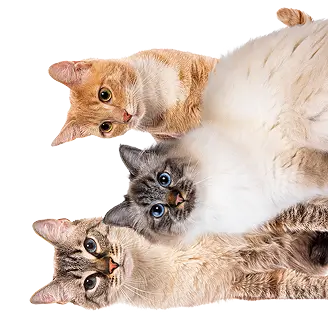Munchkin


Munchkins are built for speed and agility. They run around all over the place and sneak into the tightest of corners. They are also notable for their exceptional ability to turn on a dime despite their peculiar shape. These little bundles of joy are by no means troubled by their small size. Their tiny legs don’t hold them back, and although they tend to graze the floor as they move about, these cats are quite capable of jumping. They may not reach the height they’re aiming for in one leap, but they will find the right detours to get there in one piece! Their name comes from the film ‘The Wizard of Oz’ whose population of tiny humans had the same name!
|
Life expectancy |
The Munchkin has a life expectancy of between 13 and 20 years |
|
Adult size |
Female
Between 8 and 9 in
Male
Between 8 and 9 in
|
|
Adult weight |
Female
Between 4 and 7 lb
Male
Between 7 and 9 lb
|
|
Coat colour
Black / seal, blue / slate gray, chocolate, lilac, cinnamon, fawn, red, white. Munchkins can be any colour. |
Black Brown White Red Cream Blue |
|
Type of coat
2 varieties: one long-haired, and one short-haired. |
Short Long |
|
Eye colour
Blue/aquamarine, golden yellow, green, odd/different coloured All colours are accepted and there is no link between eye colour and coat colour. |
Blue
Green
Yellow
Odd-eyed
|
|
Purchase price |
The Munchkin costs approximately 200£ |
Interestingly, contrary to what you might think, Munchkins don’t generally suffer from back problems, like Daschunds and Basset Hounds do. Their vertebral column is similar to that of other cats, and just as flexible, meaning they don’t tend to suffer from herniated discs.
It’s also interesting to note that cats of this breed can have one of three different leg lengths:
- Standard: when upright, this cat would be around 10 cm shorter than another ‘normal’ cat
- Super short: legs are between 2 and 3 inches long (there is no precise norm)
- Rug hugger: these are the shortest legs of the three categories, measuring less than 2 inches!
More details about the Munchkin
Munchkin: Origins and history
The mutation that gave rise to the Munchkin breed is not a recent one. It appeared spontaneously in a moggy and since 1944, many cats with the ‘short leg’ mutation have been identified around the world. That said, it was in the 80s that a lady found a cat under her car with abnormally short legs, which she named Blackberry. Blackberry got pregnant and gave birth to several kittens, many of which carried the same mutated gene. One of them, called Toulouse, was used as a breeder and between the two of them, Blackberry and Toulouse produced the breed as we know it today - thanks to this mixing with moggies to diversify the gene pool.
Physical characteristics of the Munchkin
The Munchkin has an atypical physique. Its short legs are associated with a morphology of the semi-foreign type, with a global aspect reminiscent of that of the European. Balanced, it has a well-developed chest, but must not be too heavy or too thin, nor have the hollow back. The legs must show good balance and have no features that can hinder walking.
Munchkin: Characteristics
Munchkin: Behaviour
Breed compatibility Munchkin
Munchkin: Purchase price
On average, the purchase price of a Munchkin kitten is approximately £200, with price varying according to lineage, breeding, age and even sex. For your monthly budget you should allow an average of £30 per month to meet their needs by providing quality food and keeping them in good health.
Munchkin: Shedding
Light
Munchkins aren’t known for having heavier fur loss than other cats. You just need to look after their coat with a weekly brush for those with short fur, or twice a week for the short-haired kind.
Munchkin: Grooming
Weekly brushing is recommended for the short-hair variety, and twice a week for the long-haired variety.
Munchkin: Health
The life expectancy of these cats is between 13 and 20 years, with an average of about 15 years.
These cats are hardy and their unique morphology is no handicap to them.
The metabolism of these cats is no different than other cats, and their required energy expenditure is no greater than average. This means it may be advisable to calculate appropriate portions according to their weight with your vet.
Munchkins are generally robust with few health problems specific to their breed. However, there is one condition that comes up from time to time (although it is rare and not specific to the breed), called lordosis. This is a spinal condition that causes the spine’s supporting muscles to be too short, so that it sinks into the cat’s chest, exerting pressure on the lungs, trachea and heart. The condition is classified as ‘mild’ to ‘moderate’, with the most severe cases occurring in kittens, who generally won’t live past 12 weeks. Kittens suffering from a mild form of the condition can live a normal life, but may suffer from shortness of breath during physical exertion.
Munchkins can also present the same conditions as other cats, including oral diseases.
Pairings with moggy cats, as well as European Shorthairs are accepted.
It is important to choose the breeding individuals well and to vary the genepool, as there are genetic features specific to this breed. The gene (M) that codes for the Munchkin’s short legs is dominant, while the gene that coats for normal-length legs is recessive (m). This means the following combinations are possible:
Mm = short legs
Mm = standard length legs
MM = non-viable kitten






